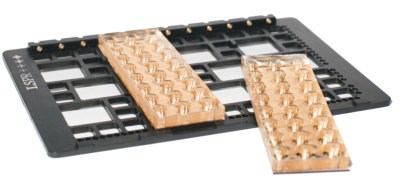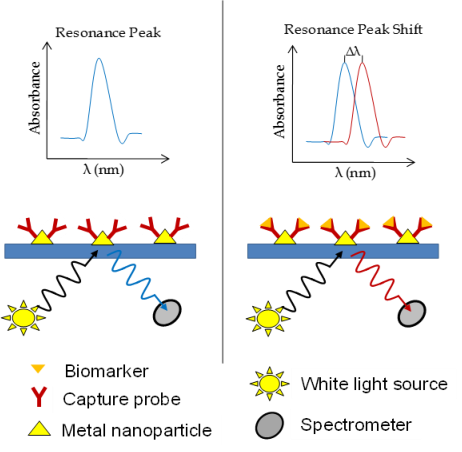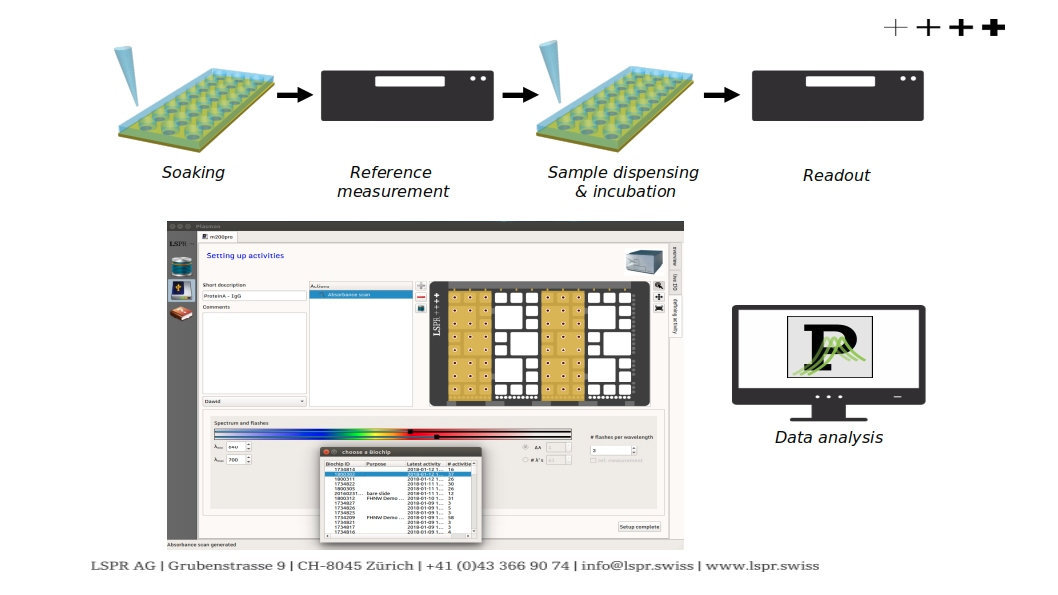LSPR
LSPR instruments utilize a broad band white light source such as an LED to illuminate the nanoparticle sensor substrate. A spectrometer serves as the detector and can be placed in either a transmission or reflection arrangement. The spectrometer provides a reading of the absorbance spectrum of the sensor substrate. The nanoparticle substrates have a characteristic absorbance peak in the visible spectrum due to the LSPR effect. The properties of this absorbance peak (spectral position, absorbance height) are dependent on the local optical properties surrounding the nanoparticles. When a molecule binds to the surface of the nanoparticle, it changes the local optical properties and causes the absorbance peak to change. The properties of the absorbance peak can be monitoring in real-time, providing time resolved molecular analysis on the nanoscale. The size, shape, and material of the nanoparticles can be tuned in order to maximize sensor performance for specific applications.
LSPR AG
LSPR AG’s technology offers high-throughput, label-free detection by industrializing Localized Surface Plasmon Resonance (LSPR) spectroscopy into a sensitive, versatile and powerful sensor for biomolecular quantification and probing of biological interaction at nanoscale without need for expensive proprietary instruments.
By utilizing the field enhancements in arrays of metallic nanostructures, LSPR AG’s biosensors enable label-free analysis that can be completed in less than an hour (for 96 samples) with an industry standard microplate reader present in the majority of biochemical laboratories.
Therefore LSPR AG’s platform constituted of:
- SBS compliant biosensors,
- Intuitive front end software, simplifies the assay build up dramatically and further decreases cost and complexity significantly.
In a typical quantitation assay, sample solutions are pipetted into the wells of the LSPR Biosensor coated with detection molecules for immobilization. Concentrations of unknown samples are determined by means of extrapolation from a calibration curve based on known antibody/protein concentrations. The dedicated software PLASMON for data collection and post-processing works with most commercial microplate readers. As the analyte-to-ligand binding is measured directly and no additional reagents are needed, it renders the method easy to use and yields presentable results in a short time. Moreover, due to the strong local field enhancements of the nanostructured sensor surface it is much less susceptible to bulk effects and measurements in complex media are more straightforward.

LSPR - Technology
Localized surface plasmon resonance (LSPR) sensors of LSPR AG are composed of highly uniform metallic nano-structure arrays and possess several so called active areas that are
designed to exhibit specific resonance absorption peaks based on their geometry, arrangement, size and material properties. Even very small changes of the
dielectric environment of the metallic nano-structures lead to detectable shifts in the plasmon resonance frequency. This effect can be used to quantify
specific molecular binding events by means of applying suitable surface modifications.
To analyze a bioassay:
- reagents, i.e. only linker, capture and analyte, are pipetted onto the wells of LSPR biosensor which is then inserted into adapter for microtiter plates,
- standard microplate reader is operated with LSPR PLASMON software to record absorption spectra of biosensor data points,
- analysis of the absorption spectra and the shift of the absorption peak reveal:
- if the analyte, e.g antibody, has bound to the capture molecule, and
- the amount of analyte, e.g. antigen that has bound to the capture molecule.
Applications
While the conventional techniques used to detect or determine the concentration of proteins have limitations, regarding timing (HPLC), throughput (SPR), cost (Bio-Layer Interferometry) or requirement for labels (ELISA), LSPR AG’s technology delivers fast, high-throughput and label-free analysis for antibody production, assay and bioprocess development in pharmaceutical and research applications. Visit LSPR AG for more information and example application notes.
LSPR - Suppliers
LSPR AG
LSPR AG is a swiss manufacturer of a broad range of SPR sensors for widely used measurement instruments. LSPR AG’s top quality thin-film coating and chemical functionalization guaranty optimum performance. Robust Hydrogel 3D surfaces and planar coatings are provided for all types of SPR instruments. In addition customized multilayer coatings of sensors, including: inorganic coatings (e.g. SiO 2 or Al 2O 3), biochemical functionalization, etc., are available to tailor the SPR response to a wide variety of special applications. Our advanced facilities and know-how in fabrication and surface chemistry enables us to provide innovative solutions in thin film technologies and bio-functionalization for customers.
Nicoya Lifesciences
![]() OpenSPR by Nicoya Lifesciences utilizes localized surface plasmon resonance (LSPR) for label-free analysis. LSPR is similar to SPR, but it uses
nanoparticles of gold rather than a continuous gold film to produce an optical resonance. LSPR’s main advantages are simplicity of the optical design,
highly tunable optical properties, no need for temperature control, and robustness. Nicoya has developed a proprietary manufacturing process to create
nanoparticle sensors that are highly uniform and stable. Sensors can be functionalized using standard immobilization and coupling chemistry.
OpenSPR by Nicoya Lifesciences utilizes localized surface plasmon resonance (LSPR) for label-free analysis. LSPR is similar to SPR, but it uses
nanoparticles of gold rather than a continuous gold film to produce an optical resonance. LSPR’s main advantages are simplicity of the optical design,
highly tunable optical properties, no need for temperature control, and robustness. Nicoya has developed a proprietary manufacturing process to create
nanoparticle sensors that are highly uniform and stable. Sensors can be functionalized using standard immobilization and coupling chemistry.


